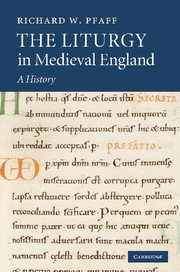Book contents
- Frontmatter
- Contents
- Preface
- Sigla and editorial conventions
- Bibliographical abbreviations
- Nicknames for manuscripts frequently referred to
- 1 Introduction
- Excursus: on sources
- 2 Early Anglo-Saxon England: a partly traceable story
- Excursus: on the terms Gregorian and Gelasian as used here
- 3 Later Anglo-Saxon: liturgy for England
- 4 The Norman Conquest: cross fertilizations
- Excursus: on method in the comparison of liturgical texts
- 5 Monastic liturgy, 1100–1215
- Excursus: on ascription of liturgical books to specific churches
- 6 Benedictine liturgy after 1215
- 7 Other monastic orders
- 8 The non-monastic religious orders: canons regular
- 9 The non-monastic religious orders: friars
- Excursus: on liturgical books from female religious houses
- 10 Old Sarum: the beginnings of Sarum Use
- 11 New Sarum and the spread of Sarum Use
- 12 Exeter: the fullness of secular liturgy
- 13 Southern England: final Sarum Use
- 14 Regional Uses and local variety
- 15 Towards the end of the story
- Index of Manuscripts
- Index of Saints
- General Index
9 - The non-monastic religious orders: friars
Published online by Cambridge University Press: 20 March 2010
- Frontmatter
- Contents
- Preface
- Sigla and editorial conventions
- Bibliographical abbreviations
- Nicknames for manuscripts frequently referred to
- 1 Introduction
- Excursus: on sources
- 2 Early Anglo-Saxon England: a partly traceable story
- Excursus: on the terms Gregorian and Gelasian as used here
- 3 Later Anglo-Saxon: liturgy for England
- 4 The Norman Conquest: cross fertilizations
- Excursus: on method in the comparison of liturgical texts
- 5 Monastic liturgy, 1100–1215
- Excursus: on ascription of liturgical books to specific churches
- 6 Benedictine liturgy after 1215
- 7 Other monastic orders
- 8 The non-monastic religious orders: canons regular
- 9 The non-monastic religious orders: friars
- Excursus: on liturgical books from female religious houses
- 10 Old Sarum: the beginnings of Sarum Use
- 11 New Sarum and the spread of Sarum Use
- 12 Exeter: the fullness of secular liturgy
- 13 Southern England: final Sarum Use
- 14 Regional Uses and local variety
- 15 Towards the end of the story
- Index of Manuscripts
- Index of Saints
- General Index
Summary
Dominicans
Each of the major orders of friars went through an initial phase of trial and error in seeking definition, clear identification, and regulation. After a generation or so these hallmarks had for the most part been achieved, though questions, often leading to vigorous controversies, remained. It is only after some of these had been settled on the Continent that the various groups appeared in England: Dominicans first, in 1221, Franciscans in 1224, Carmelites in 1241, Austin Friars in 1248. By those dates the notes of papal approval, composition and acceptance of a rule (sometimes more than one), and establishment of a system of continuing centralized governance are discernible for each of these orders; but the regulation of worship tends to come relatively late and, as would be expected, to be an ongoing process. So our task will be to try to sense what would have been the situation during the early years of the presence of each of these groups in England, then to notice the effects of the more or less normative regulations for each group, and finally to get some feel for their adaptations to local circumstances and their inclusions of English saints in their service books.
When the first Dominican friars arrived in England in 1221, the order – Ordo praedicatorum, colloquially called Black Friars – had been in existence for less than a decade. Among the principal houses came to be those at Cambridge, Canterbury, Gloucester, King's Langley, London, Northampton, Norwich, Oxford, Winchester, and York. The story of their quick rise to prominence and popularity in England, in circles academic, royal, and merely urban, cannot be gone into here.
- Type
- Chapter
- Information
- The Liturgy in Medieval EnglandA History, pp. 311 - 341Publisher: Cambridge University PressPrint publication year: 2009



